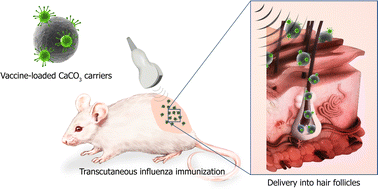Non-invasive transcutaneous influenza immunization using vaccine-loaded vaterite particles
Abstract
Transcutaneous immunization receives much attention due to the recognition of a complex network of immunoregulatory cells in various layers of the skin. The elaboration of non-invasive needle-free approaches towards antigen delivery holds especially great potential here while searching for a hygienically optimal vaccination strategy. Here, we report on a novel protocol for transfollicular immunization aiming at delivery of an inactivated influenza vaccine to perifollicular antigen presenting cells without disrupting the stratum corneum integrity. Porous calcium carbonate (vaterite) submicron carriers and sonophoresis were utilized for this purpose. Transportation of the vaccine-loaded particles into hair follicles of mice was assessed in vivo via optical coherence tomography monitoring. The effectiveness of the designed immunization protocol was further demonstrated in an animal model by means of micro-neutralization and enzyme-linked immunosorbent assays. The titers of secreted virus-specific IgGs were compared to those obtained in response to intramuscular immunization using conventional influenza vaccine formulation demonstrating no statistically significant differences in antibody levels between the groups. The findings of our pilot study render the intra-follicular delivery of the inactivated influenza vaccine by means of vaterite carriers a promising alternative to invasive immunization.



 Please wait while we load your content...
Please wait while we load your content...